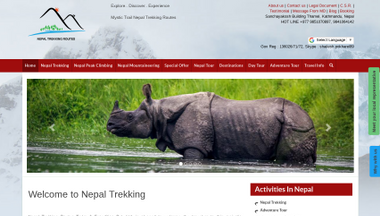Other Routes – part 2.
![]() American expedition, led by Norman Dyhrenfurth. First ascent by an American: Jim Whittaker; first ascent of the West Ridge on May 22, 1963 by Americans Tom Hornbein and Willi Unsoeld.
American expedition, led by Norman Dyhrenfurth. First ascent by an American: Jim Whittaker; first ascent of the West Ridge on May 22, 1963 by Americans Tom Hornbein and Willi Unsoeld.

1963: American Expedition with Norman Dyhrenfurth as leader and including A. Auten, Barry Bishop, Jake Breitenbach, J. Corbet, D. Dingman, D. Doody, R. Emerson, Tom Hornbein, Lute Jerstad, J. Lester, Willi Unsoeld, and Jim Whittaker. A huge expedition, costing almost $400,000 and supported by the National Geographic Society, over 900 porters carry 29 tons of food and equipment to the base of the mountain. Base Camp is established at the foot of the Khumbu Icefall on Mar 21 and the route through the icefall prepared soon after. Jake Breitenbach is killed by collapsing seracs in the Icefall but the expedition continues. The expedition splits into two parties – the West Ridgers and the South Collers.
First Assault: May 1 From Camp 6 at 27,450 feet (8370 meters) on the SE Ridge, Jim Whittaker and Nawang Gombu Sherpa reach the summit in strong winds at 1 PM. Whittaker becomes the first American to summit Everest.
Second Assault: After a tent at Camp 4W – including occupants – is nearly blown off the West Shoulder by hurricane force winds, Camp 5W is placed in the Hornbien Couloir at the foot of the Yellow Band at 27,250 feet (8300 meters). Tom Hornbein and Willi Unsoeld squeeze their way through the couloir and ascend a 60 foot (20 meter) headwall before emerging onto the upper summit pyramid at 27,900 feet (8500 meters). The pair then traverse across to the West Ridge proper, reaching the summit at 6:15 PM. They are forced to descend the SE Ridge where they meet Jerstad and Bishop who had summited at 3:30 PM. The four men descend to around 28,000 feet (8500 meters) before having to bivouac for the night on the ridge proper. They survive a long, cold night out in the open and descend safely to the South Col the next day. Unsoeld later loses most of his toes to frostbite. The first new route and the first traverse of Everest.
Droga amerykańskiej wyprawy z 1963r kierowanej przez Normana Dyhrenfurtha.
22 maja Tom Hornbein i Willi Unsoeld wytyczyli nową droge po pokonaniu odcinka : zachodnim grzbietem, zachodnią granią i dalej kuluarem ( obecnie nazywanym Kuluarem Hornbeina ), który wcina się w północną scianę, dochodząc w końcu do wierzchołka.
![]() The British SW face expedition led by Chris Bonington. Summit reached by 2 teams made up with Doug Scott, Dougal Haston, Peter Boardman, and Sirdar Pertemba. BBC cameraman Mick Burke failed to return from a solo summit bid.
The British SW face expedition led by Chris Bonington. Summit reached by 2 teams made up with Doug Scott, Dougal Haston, Peter Boardman, and Sirdar Pertemba. BBC cameraman Mick Burke failed to return from a solo summit bid.

1975: Chinese Expedition led by Shih Chan-chun, leader of the 1960 Chinese ascent, and organized by a “Party Committee” that included Wang Fu-chou, one of the 1960 summiters. A military-style expedition that uses soldiers to carry supplies to the North Col and siege tactics to progressively reposition camps higher and higher up the mountain. A final assault camp is established between the First and Second Steps at 28,500 feet (8,680 meters) by the Mushroom Rock, and the Second Step is prepared with an aluminum ladder to overcome the final vertical headwall pitch. A team of nine climbers – eight Tibetan and one Chinese – reaches the summit on May 27, including the Tibetan woman, Phantog. Phantog becomes the second woman to summit Everest, losing this honor to Junko Tabei by only a few days. She is the first woman to summit from the Tibetan side.
1975: British SW Face Expedition (post-monsoon). Leader Chris Bonington and including H. MacInnes, Peter Boardman, Martin Boysen, P. Braithwaite, Micke Burke, M. Cheney, C. Clarke, Nick Estcourt, Dougal Haston, and Doug Scott. Base Camp is reached on August 22 and Advance Base is established on September 2. The expedition is blessed with good weather and smooth logistics, resulting in the steady placement of camps up the Central Gully to Camp 5 at 25,500 feet (7800 meters). The Rock Band is ascended via a gully on the left side by Estcourt and Braithwaite, who have some sporty moments when their oxygen runs out on dicey pitches at 27,000 feet (8200 meters). The upper icefield is reached via an awkward outward-sloping ramp; Haston and Scott establish Camp 6 a few days later at an elevation of 27,300 feet (8300 meters). The next day they fix 1,500 feet of rope on the upper snowfield, extending the route towards a gully leading up to the South Summit.
First Assault: Sept 24: Haston and Scott reach the South Summit at 3 PM after 11 hours of climbing. After preparing a snow cave and drinking a brew, they continue on to the summit which they reach at 6 PM. They descend to the South Summit and bivouac in the snowcave. After a freezing, oxygenless night complete with hypoxic conversations with feet, toes, and imaginary companions, the pair descend to Camp 6 safely, passing the second assault party on their way up.
Second Assault: Sept 26: Boardman and Sirdar Pertemba reach the summit and descend in a gathering storm, where they encounter Mick Burke just below the summit. They wait for him as long as possible before descending, but Burke is never seen alive again. He probably made the top but fell off of the heavily corniced summit ridge while descending in the deteriorating conditions.
Droga brytyjskiej wyprawy z 1975r kierowanej przez Chrisa Boningtona, wejście południowo – zachodnią ściana. 24 września na szczyt dotarli Dougal Haston i Doug Scott.
** Poprzednie posty :
– Routes – part 4. Drogi do celu. cz.4. /Version polish and english/
– Routes – part 3.Drogi do celu. cz.3. /Version polish and english/
– Routes – part 2.Drogi do celu. cz.2. /Version polish and english/
– Routes – part 1.Drogi do celu. cz.1. /Version polish and english/
** zapraszam na relacje z wypraw polskich himalaistów.
zapraszam do subskrypcji mego bloga
Filed under: drogi do celu, Expedition, Routes, Travel | Tagged: Base Camp, Chris Bonington, Edmund Hillary, Everest, Expedition, Khumbu glacier, Khumbu Icefall, Lhotse, Norman Dyhrenfurth, Nuptse, routs, Tom Hornbein, Travel, Willi Unsoeld |






























very nice story to share with us…thanks if not i will never know wht actually happenend at the summit…:D
Dear friend,
excuse me off topic pls, I’m very interested in the theme I described here:
http://vacation-travel-talk.blogspot.com/2008/02/valley-of-death-in-tibet.html
that seems to me very amazing.
The problem is I did not find any information about it.
That is why I alow me to disturb you with the question: maybe you know something about it?
Thank you very much for your time
Sincerely
Ja offtopowo trochę w zwiazku z newsem na onecie:
http://wiadomosci.onet.pl/1689459,11,item.html
“Artur Hajzer – jeden z najbardziej znanych polskich alpinistów i himalaistów został porwany przez lawinę jaka zeszła w rejonie Ciemniaka w paśmie Czerwonych Wierchów w Tatrach Zachodnich.
Artur Hajzer jest jedyną poszkodowaną osobą w tej lawinie. Trafił już do szpitala.
– Jest w dobrym stanie. Jest tylko lekko wychłodzony, więc go ogrzewamy, no i zostanie zatrzymany na obserwacji – powiedział doktor Sylweriusz Kosiński z zakopiańskiego szpitala. Dodał, że mężczyzna był bardzo dobrze wyekwipowany. Alpinista znał też zasady zachowania się w lawinie. Według ratownika dyżurnego, w rejonie Ciemniaka poruszała się trzyosobowa grupa alpinistów i jeden z nich najprawdopodobniej wszedł na nawis śnieżny i to spowodowało zejście lawiny, która go porwała.”
Tak przy okazji,może napisałbyś artykuł (może już był, ale nie pamiętam) jak zależy się zachowywać gdy człowiek znajdzie się na linii lawiny…. i nie ma dokąd uciec… koniecznie po polsku 🙂
Oby wiecej takich artykulow…